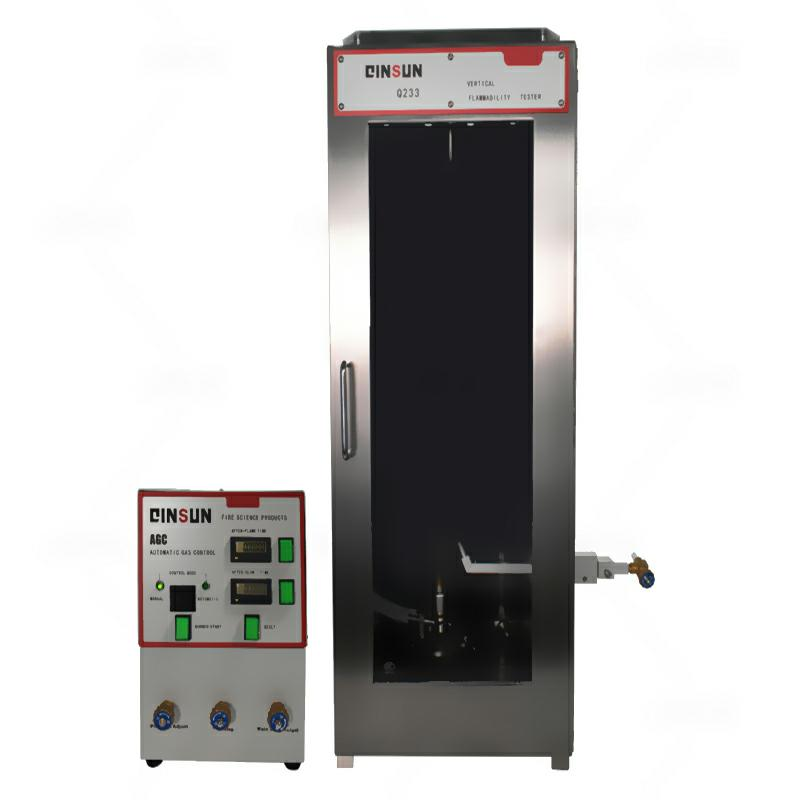Time: Popularity:0times
The Vertical Flame Tester can test the flammability of children's sleepwear or decorative fabrics. Its sealed stainless steel combustion chamber, observation window, and standard burner accurately measure flame spread rate. It is equipped with various specimen holders and accessory test kits to meet various test standards. An automatic gas control system allows for easy control of sample progress. It is suitable for determining the flame retardancy of flame-retardant woven and knitted fabrics, coated products, and laminated products. It can also be used to determine the tendency of textiles to after-flame, smolder, and char.
The horizontal and vertical combustion tester consists of the following components:
Combustion Chamber: The combustion chamber is the core component of the test, simulating the combustion conditions of a fire scene. It includes a fuel source, ignition device, combustion source, and smoke detector.
Horizontal Combustion Apparatus: The horizontal combustion apparatus supports horizontal combustion tests and includes a horizontal combustion test platform, support frame, and slide rails.
Vertical Combustion Apparatus: The vertical combustion apparatus supports vertical combustion tests and includes a vertical combustion test platform, support frame, and slide rails.
1. Connect the gas pipe to the burner, control box, and gas tank. Check the gas pipe connections for leaks.
2. Turn on the power switch 9 and set the flame time 1, afterflame time 2, and afterburn time 3 as required (they can be set to a shorter time during commissioning).
3. Clamp the sample and tilt the burner to a specific angle (0°, 20°, or 45°). Adjust the fixture 30 and sample to the test position.
4. Set the gas flow control valve to the minimum setting.
5. Open the main valve of the gas tank, connect the gas source, press the gas supply button 10, and simultaneously ignite and adjust the flame with a lighter or match. Adjust the gas pressure regulating valve to 0.1 MPa. Adjust the gas flow regulating valve 14 and ensure that the gas back pressure (U-type pressure gauge 26) reaches the appropriate pressure to achieve the desired flame height. The burner should be in a vertical position during ignition. (If using a premix burner, also connect the compressed air source and adjust the pressure to 0.1 MPa. Adjust the air flow regulating valve 15 to achieve the desired flame height.)
1. Use equipment according to the manual and strictly adhere to operating procedures. Prepare carefully before startup, inspect the equipment repeatedly during startup, make adjustments, and strictly adhere to operating specifications. Avoid overheating, overpressure, overspeeding, or overloading.
2. Perform meticulous maintenance, regularly check routes, and thoroughly inspect equipment. Identify problems and promptly resolve them, eliminating potential hazards. Ensure proper cleaning, lubrication, tightening, adjustment, and corrosion protection of equipment. Keep parts, accessories, and tools intact.
3. Understand the prevention, diagnosis, and emergency response measures for equipment failures, and maintain intact and functional safety devices.
4. Operate equipment according to schedules, perform regular replacements, and cooperate with maintenance personnel to ensure equipment is always in good condition and ready for operation. Regularly check spare equipment and ensure proper frost and condensation protection.
5. Carefully complete equipment operation records, defect records, and operation diaries.
6. Maintain the equipment and surroundings clean and hygienic at all times, ensuring that grooves are visible, shafts are exposed to light, the equipment is visible, and the glass on doors and windows is clean.
7. Maintain proper equipment lubrication. Regularly clean and change lubrication areas and oil tanks.
Aerospace: The aerospace industry has strict requirements for the combustion performance of materials. Testing with a horizontal and vertical flame tester can ensure the safety of materials in fires and avoid serious consequences caused by burning or melting.
Automotive: In the automotive industry, the combustion performance of materials is crucial to vehicle safety. Testing with a horizontal and vertical flame tester can be used to evaluate the fire safety of automotive interior materials, seat materials, and other materials.
Construction: In the construction industry, the combustion performance of materials is a key indicator of building safety. Testing with a horizontal and vertical flame tester can be used to evaluate the fire safety of building materials, protecting people's lives and property.

Company Phone
+86-21-6420 0566
Working hours
Monday to Friday
Mobile phone:
13816217984
Email:
info@qinsun-lab.com
